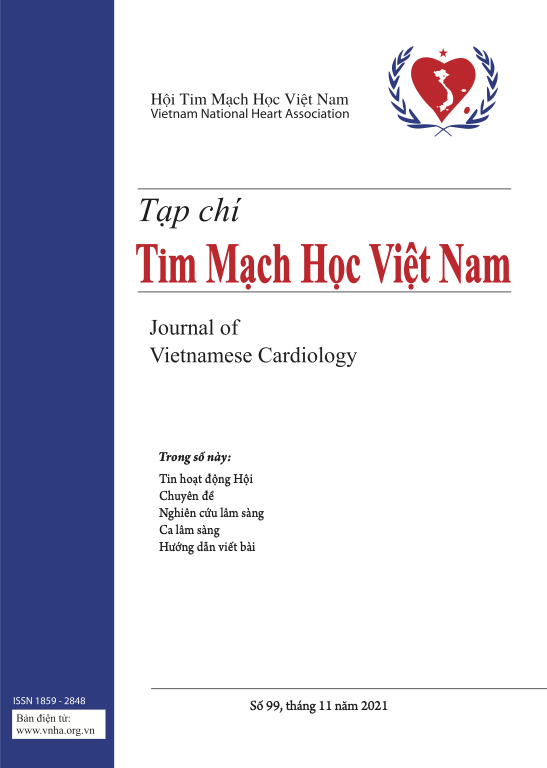Vị trí của digoxin trong điều trị suy tim
DOI:
https://doi.org/10.58354/jvc.99.2022.4Tóm tắt
Qua phân tích các chứng cứ nêu trên và tham khảo các hướng dẫn điều trị hiện hành, có thể kết luận tóm tắt về việc dùng digoxin điều trị suy tim mạn như trong bảng 2.
Bảng 2: Vị trí của digoxin trong điều trị suy tim mạn
Người bệnh suy tim rung nhĩ:
- PSTM <40%: Digoxin và thuốc chẹn bêta là 2 lựa chọn hàng đầu để kiểm soát tần số thất. Có thể
phối hợp 2 thuốc này với nhau nếu đơn trị không đủ để kiểm soát tần số thất.
- PSTM ≥40%: Thuốc chẹn bêta, verapamil và diltiazem là những lựa chọn hàng đầu để kiểm soát tần
số thất. Nếu đơn trị bằng các thuốc này không đủ để kiểm soát tần số thất, xem xét phối hợp thêm
digoxin.
- Dùng liều digoxin ≤0,125 mg/ngày.
- Không dùng digoxin cho người có hội chứng kích thích sớm.
Người bệnh suy tim nhịp xoang:
- PSTM <40%, tình trạng lâm sàng ổn định, đang uống digoxin: tiếp tục dùng.
- PSTM <40%, không đang uống digoxin: Digoxin không phải là thuốc được ưu tiên kê toa. Ưu tiên
dùng các thuốc giảm tử vong và nhập viện vì suy tim (hàng 1: sacubitril/valsartan, chẹn bêta, kháng
aldosterone, ức chế SGLT2; hàng 2: ivabradine nếu tần số tim ≥70/phút). Nếu bệnh nhân vẫn còn
triệu chứng, xem xét phối hợp thêm digoxin để giảm nguy cơ nhập viện.
- Dùng liều digoxin ≤0,125 mg/ngày.
- PSTM ≥40%: không có chỉ định dùng digoxin.
Tài liệu tham khảo
1. Wilkins MR, Kendall MJ, Wade OL. William Withering and digitalis, 1785 to 1985. BMJ 1985;290:7-8.
![]()
2. Ferrari F, Santander IRMF, Stein R. Digoxin in atrial fibrillation: An old topic revisited. Current Cardiology Reviews 2020;16:141-146.
![]()
3. Patel N, Ju C, Macon C, et al. Temporal trends of digoxin use in patients hospitalized with heart failure: Analysis from the American Heart Association Get With The Guidelines-Heart Failure Registry. J Am Coll Cardiol HF 2016;4:348-356.
![]()
4. Teerlink JR, Sliwa K, Opie LH. Heart failure. In: Opie LH, Gersh BJ, eds. Drugs for the heart, 8th edition. Elsevier Saunders 2013, p.201-207.
![]()
5. Ahmed A, Pitt B, Rahimtoola SH, et al. Effects of digoxin at low serum concentrations on mortality and hospitalization in heart failure: A propensity match study of the DIG trial. Int J Cardiol 2008;123:138-146.
![]()
6. Kotecha D, Bunting KV, Simrat KG, et al, for the Rate Control Therapy Evaluation in Permanent Atrial Fibrillation (RATE-AF) Team. Effect of digoxin vs bisoprolol for heart rate control in atrial fibrillation on patient-reported quality of life: The RATE-AF randomized clinical trial. JAMA 2020;324:2497-2508.
![]()
7. Ouyang AH, Lu YN, Zhong HL, et al. Meta-analysis of digoxin use and risk of mortality in patients with atrial fibrillation. Am J Cardiol 2015;115:901-906.
![]()
8. Vamos M, Erath JW, Hohnloser SH. Digoxin-associated mortality: a systematic review and meta-analysis of the literature. Eur Heart J 2015, doi:10.1093/eurheartj/ehv143.
![]()
9. Bavishi C, Khan AR, Ather S. Digoxin in patients with atrial fibrillation and heart failure: a meta-analysis. Int J Cardiol 2015;188:99-101.
![]()
10. Qureshi W, O’Neal WT, Soliman EZ, Al-Mallah MH. Systematic review and meta-analysis of mortality and digoxin use in atrial fibrillation. Cardiol J 2016;23:333-343.
![]()
11. Vamos M, Erath JW, Benz AP, et al. Meta-analysis of effects of digoxin on survival in patients with atrial fibrillation or heart failure: An update. Am J Cardiol 2019;123:69-74.
![]()
12. Sethi NJ, Nielsen EE, Safi S, et al. Digoxin for atrial fibrillation and atrial flutter: A systematic review with meta-analysis and trial sequential analysis of randomised clinical trials. PLOS ONE 2018, https://doi. org/10.1371/journal.pone.0193924.
![]()
13. Lopes RD, Rordorf R, De Ferrari GM, et al, for the ARISTOTLE Committees and Investigators. Digoxin and mortality in patients with atrial fibrillation. J Am Coll Cardiol 2018;71:1063-1074.
![]()
14. Hindricks G, Potpara T, Dagres N, et al. 2020 ESC Guidelines for the diagnosis and management of atrial fibrillation developed in collaboration with the European Association of Cardio-Thoracic Surgery (EACTS). Eur Heart J 2020, doi:10.1093/eurheartj/ehaa612.
![]()
15. Packer M, Gheorghiade M, Young JB, et al, for the RADIANCE Study. Withdrawal of digoxin from patients with chronic heart failure treated with angiotensin-converting-enzyme inhibitors. N Engl J Med 1993;329:1-7.
![]()
16. Uretsky BF, Young JB, Shahidi FE, et al, on behalf of the PROVED Investigative Group. Randomized study assessing the effect of digoxin withdrawal in patients with mild to moderate chronic congestive heart failure: Results of the PROVED Trial. J Am Coll Cardiol 1993;22:955-962.
![]()
17. The Digitalis Investigation Group. The effect of digoxin on mortality and morbidity in patients with heart failure. N Engl J Med 1997;336:525-533.
![]()
18. Rathore SS, Curtis JP, Wang Y, et al. Association of serum digoxin concentration and outcomes in patients with heart failure. JAMA 2003;289:871-878.
![]()
19. McDonagh TA, Metra M, Adamo M, et al. 2021 ESC Guidelines for the diagnosis and treatment of acute and chronic heart failure. Eur Heart J 2021, doi:10.1093/eurheartj/ehab368.
![]()
Tải xuống
Đã Xuất bản
Các phiên bản
- 03-03-2023 (2)
- 30-11-2022 (1)








